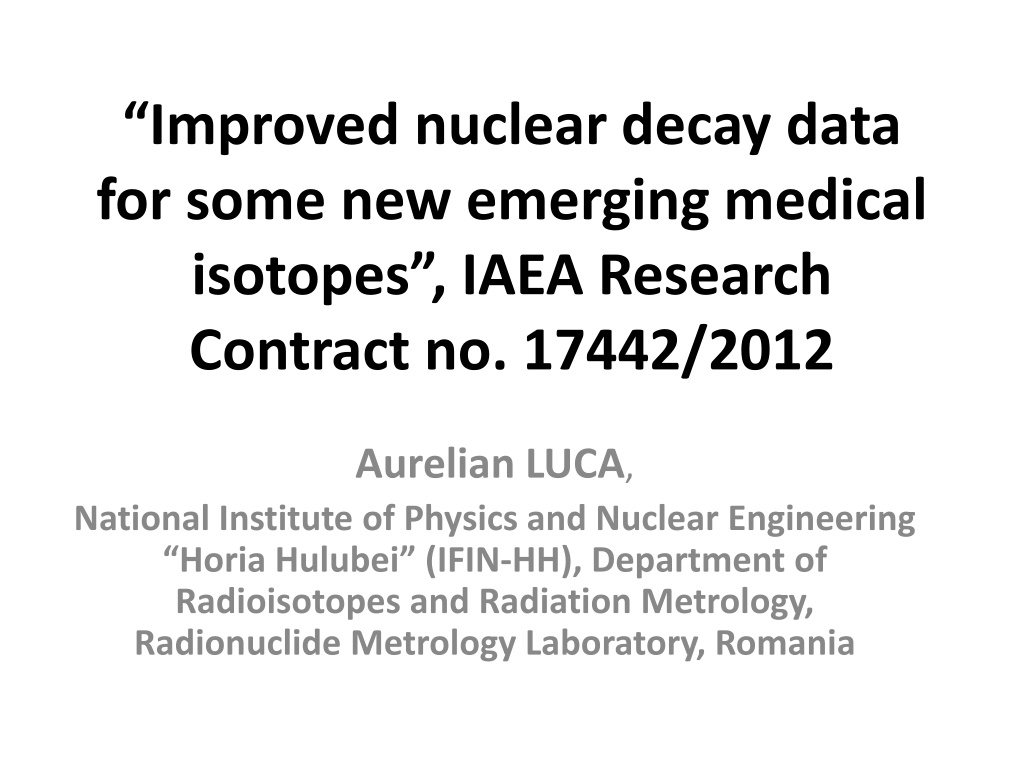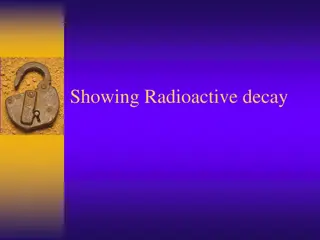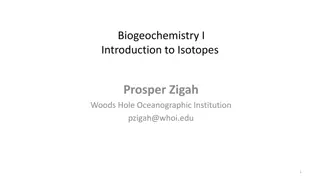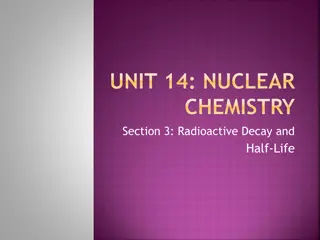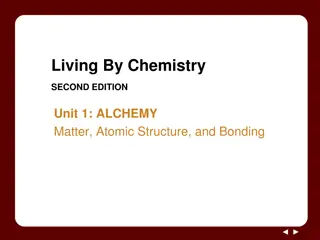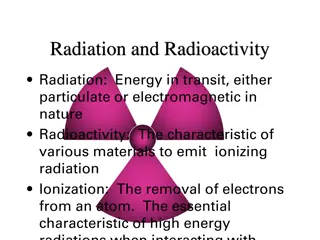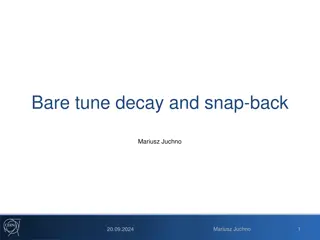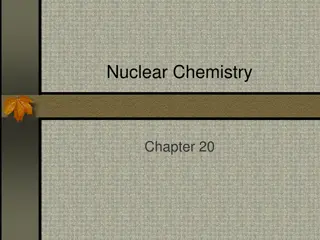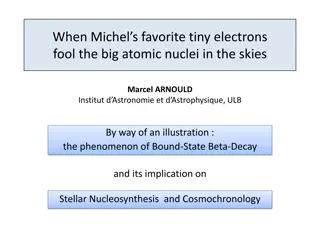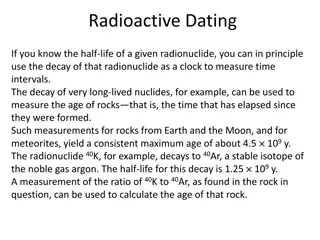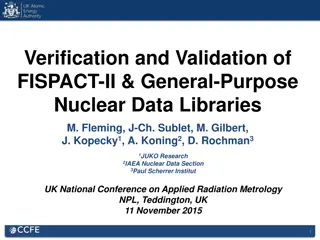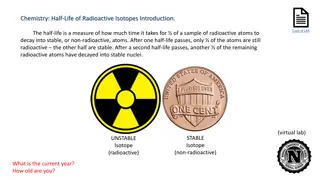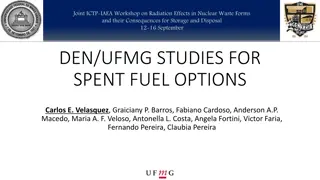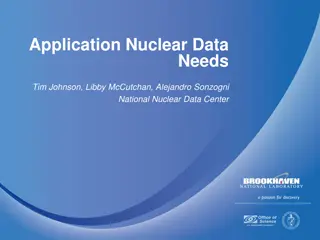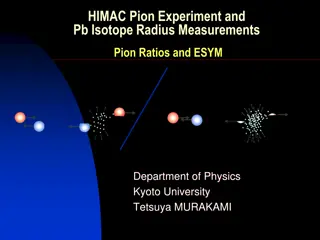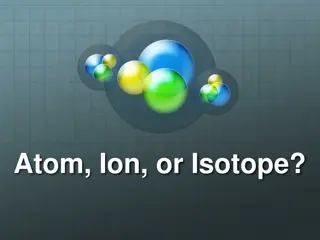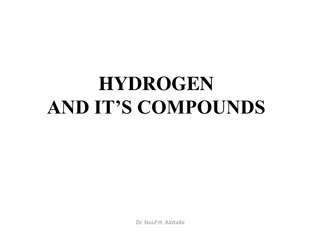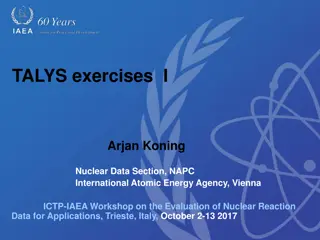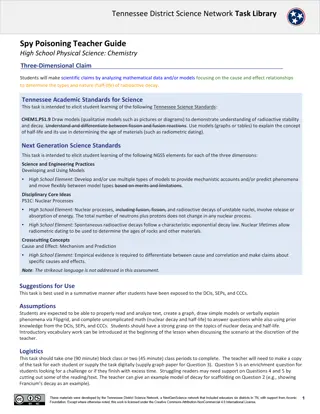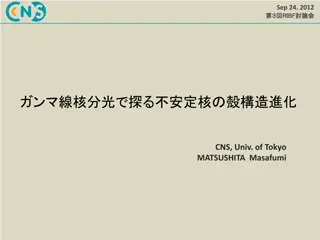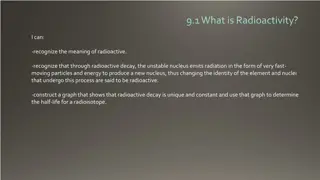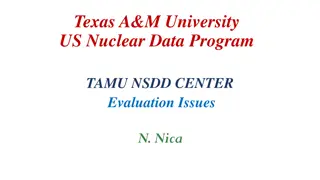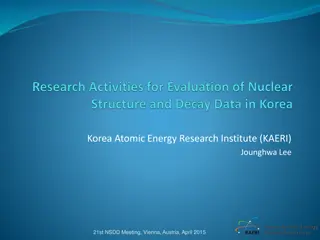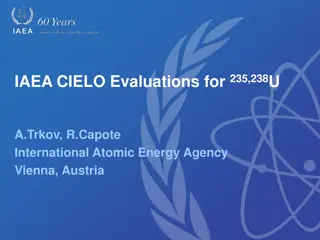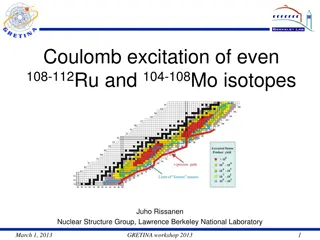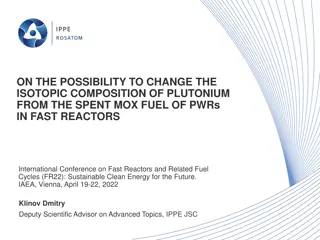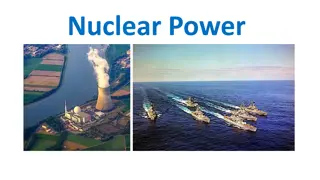Enhanced Nuclear Decay Data for Medical Isotopes Research
Improved nuclear decay data for emerging medical isotopes was evaluated as part of an IAEA research contract. The process involved reviewing previous evaluations, gathering experimental data, compiling decay data sets, and disseminating results. Challenges at IFIN-HH/LMR included limited funding and manpower. The main result focused on the evaluation of 52Fe with references from various sources.
Download Presentation

Please find below an Image/Link to download the presentation.
The content on the website is provided AS IS for your information and personal use only. It may not be sold, licensed, or shared on other websites without obtaining consent from the author. Download presentation by click this link. If you encounter any issues during the download, it is possible that the publisher has removed the file from their server.
E N D
Presentation Transcript
Improved nuclear decay data for some new emerging medical isotopes , IAEA Research Contract no. 17442/2012 Aurelian LUCA, National Institute of Physics and Nuclear Engineering Horia Hulubei (IFIN-HH), Department of Radioisotopes and Radiation Metrology, Radionuclide Metrology Laboratory, Romania
Introduction Participation at the 1stRCM of the CRP, Nuclear Data for Charged-particle Monitor Reactions and Medical Isotope Production (CRP no. F41029), at IAEA, Vienna, Austria, 3-7 December 2012 Nuclear decay data evaluations for the radionuclides: 52Fe and, as agreed afterwards with LNHB, CEA-Saclay, France, 230U( ) and 226Th( ).
Procedures (DDEP): Review of previous evaluations, if available; Gather experimental data from databases; Compilation and evaluation of nuclear decay data sets; Analysis and consistency test of the decay schemes; Dissemination of the results (articles, presentations at conferences).
Some difficulties at IFIN-HH/LMR: Limited sources of funding for these evaluations and many other research topics and applications to be covered (Radionuclide Metrology Lab, accredited for standardization and testing) ; Lack of man-power Training requirements (IFIN-HH organized the DDEP-2014 Workshop, at Magurele, Romania, 6-8 October 2014, http://ddep14.nipne.ro, but very evaluators participated).
Main result: Evaluation of 52Fe There was no other evaluation published in the DDEP database (http://www.nucleide.org/DDEP.htm) 16 references were identified and selected to be used for this evaluations (sources: NSR from NNDC, USA; libraries of IFIN-HH and CEA- Saclay, France; articles from Xiaolong Huang, CIAE/CNDC, China)
References List (1): [1] A.L. Nichols, R. Capote Noy, Summary Report First Coordination Meeting on Nuclear Data for Charged-particle Monitor Reactions and Medical Isotope Production, INDC(NDS)-0630, IAEA Nuclear Data Section, Vienna International Centre, A-1400 Vienna, Austria, February 2013 [2] 2007Hu08 Junde Huo, Su Huo, Chunhui Ma. Nucl. Data Sheets 108 (2007) 773. Spin and Parity, Level energies, Half-life, Multipolarities [3] 1959Ju40 J.O. Juliano, C.W. Kocher, T.D. Nainan, A.C.G. Mitchell. Phys. Rev. 113 (1959) 602. Half-life, Electron Capture/Beta plus ratio [4] 1960Ka20 T. Katoh, M. Nozawa, Y. Yoshizawa, Y. Koh. J. Phys. Soc. Jpn. 15 (1960) 2140. Half-life, Multipolarities [5] 2012Wa38 - M. Wang, G. Audi, A.H. Wapstra, F.G. Kondev, M. MacCormick, X. Xu, B. Pfeiffer. Chin. Phys. C36 (2012) 1603. Q-value [6] 1967Pa22 A. Pakkanen. An. Acad. Sci. Fenn. Series A, VI, 253 (1967) 25. Half-life [7] 1974Ro18 S.J. Rothman, N.L. Peterson, W.K. Chen, J.J. Hines, R. Bastar, L.C. Robinson, L.J. Nowicki, J.B. Anderson. Phys. Rev. C 9 (1974) 2272. Half-life
References List (2): [8] 1971Sa21 - G.B. Saha, P.A. Farrer. Int. J. Appl. Radiat. Isot. 22 (1971) 495. Half-life [9] 1948Mi12 D.R. Miller, R.C. Thompson, B.B. Cunningham. Phys. Rev. 74 (1948) 347. Half-life [10] 1998Sc28 - E. Sch nfeld, .Appl. Radiat. Isot. 49 (1998) 1353. Fractional EC probabilities [11] 1956Ar33 E. Arbman, N. Svartholm. Ark. Fysik 10 (1956) 1. Positron emission energy [12] 1971Go40 - N.B. Gove, M.J. Martin. Nucl. Data Tables 10 (1971) 205. EC/positron ratios, log ft [13] 1977Ya08 - R.P. Yaffe, R.A. Meyer. Phys. Rev. C 16 (1977) 1581. Gamma ray energies, Gamma-ray relative emission probabilities [14] 1972McYW L.D. McIsaac, R.J. Gehrke. ANCR-1088 (1972) 384. Gamma ray energies, Gamma-ray relative emission probabilities [15] 2008Ki07 - T. Kib di, T.W. Burrows, M.B. Trzhaskovskaya, P.M. Davidson, C.W. Nestor Jr. Nucl. Instrum. Meth. Phys. Res. A 589 (2008) 202. Theoretical ICC [16] 1996Sc06 - E. Sch nfeld, H. Janssen. Nucl. Instrum. Meth. Phys. Res. A 369 (1996) 527. Atomic Data [17] 2000Sc47 - E. Sch nfeld, H. Janssen. Appl. Radiat. Isot. 52 (2000) 595. P(X), P(Ae)
Evaluation of 52Fe (cont.) The evaluation was peer-reviewed by a DDEP reviewer (Dr. Alan Nichols) during November 2013 February 2014 and the proposed modifications were implemented in the final version of the evaluation in order to improve the results. The Evaluation was published in the DDEP database (NUCLEIDE) since March 7, 2014 and will be included in the next Monographie BIPM-5, Vol. 8.
Evaluation of 52Fe (cont.) 52Fe decays 100% by electron capture and + to excited levels and the ground state of 52Mn. The isomer 52mMn is created within this decay chain: the excitation energy is 377.7 keV and the half-life 21.1(2) minutes, according to Junde Huo, Su Huo, Chunhui Ma. Nucl. Data Sheets 108 (2007) 773.
Evaluation of 52Fe (cont.) The decay energy value for the 52Fe decay, Q(EC), was adopted from Wang et al. (2012): 2375 (6) keV The spins, parities and level energies are adopted from the most recent mass-chain evaluation published for A=52 (Junde Huo et al., 2007). There is no information available about the spin and parity of the 1417.7 keV energy level of 52Mn.
52Fe Half-life: T1/2 , Table 1 T1/2 (h) uc(h) Reference, NSR keynumber 1959Ju40 Two other values reported without uncertainty were not taken into account: Saha and Farrer (1971Sa21), 8.2 h and Miller et al. (1948Mi12), 7.8 h. The adopted data set is consistent. 8.2 0.1 1967Pa22 8.23 0.04 1974Ro18 8.275 0.008 Adopted value: 8.273 0.008
52Fe: Electron Capture and +transitions All electron capture (EC) and +energies were derived from the nuclear level energies and the Q value. Shell and sub-shells capture probabilities were calculated by means of the EC-Capture program (1998Sc28). There are two electron capture transitions feeding the excited states of 1417.7 keV and 546.4 keV and only one +transition with the energy 806 (7) keV in competition with EC.
The probabilities of the two EC transitions and the allowed + transition were calculated from the decay scheme balance and the theoretical ratio (EC/ +) computed by the LOG FT program from the theoretical tables of Gove et al. (1971Go40). This theoretical ratio was 0.780 (21), in agreement with the experimental value of 0.770 from 1959Ju40. The total (EC + +) transition probability to the excited state of 546.4 keV (52Mn) is 99.9 (15) %. The LOG FT program was also used to calculate the log ft values for the EC and + transitions.
Electron capture (EC) and + transitions in the 52Fe decay, Table 2 Lg ft PK PL PM Transition Energy (keV) Probability Nature (%) EC(0,3) 957 (6) 0.095 (4) 5.8 0.8892 (16) 0.8898 (16) - 0.0950 (13) 0.0946 (13) - 0.0151 (5) 0.0150 (5) - EC(0,2) 1829 (6) 43.8 (13) Allowed 4.7 +(0,2) 807 (6) 56.1 (7) Allowed 4.7
52Fe decay: Gamma-ray transitions Only one measurement of the gamma-rays energy and relative emission probabilities was found in the literature: Yaffe and Meyer (1977), 1977Ya08. The 377.749 keV gamma ray is the IT-decay process of 52mMn directly to the ground state of 52Mn. A reference intensity of 1000 was adopted for the emission probability of the 1434.06 (1) keV gamma-ray (this gamma transition follows the 52mMn electron capture and + transitions populating the nuclear levels of 52Cr).
52Fe decay: Gamma-ray transitions The adopted Internal Conversion Coefficients (ICC) are the theoretical values calculated by the BrIcc program (Tibor Kibedi et al., 2008). The normalization factor (N), was calculated from the condition that 100 % of the transitions ( +, EC, with the exception of the isomeric transition) in the decay of 52Fe populate the first excited (isomeric) state of the 52mMn daughter at 377.7 keV:
Normalization Factor: where: P 168and P 1039 are the relative emission probabilities of the 168.6-keV and 1039.9-keV gamma-rays, respectively, T168and T1039 are the total internal conversion coefficients of the two transitions, and N is the normalization factor between the relative and absolute -ray probabilities: N=0.0961 0.0019
52Fe decay: Gamma-ray transitions Using this factor and the adopted relative -ray emission probabilities (see Table 3 below), the absolute -ray emission probabilities were calculated for 377.7-keV and 1039.9-keV (Table 5). The 168.6-keV gamma ray emission probability was computed from the decay scheme balance (total gamma transition probability) and the corresponding adopted ICC value, while the 511- keV emission intensity is twice the + transition probability, i.e. 112.2 (14) %.
Energy and relative emission probability of the gamma-rays following the 52Fe decay, Table 3 Transition Energy and uncertainty (keV) Relative emission probabilities and uncertainties, Yaffe and Meyer (1977) (intial and final levels) (i,f) E E (uc) Pi Pi (uc) (2, 1) 168.689 0.008 1032 20 (1, 0) 377.749 0.005 17.09 0.15 (3, 1) 1039.939 0.019 0.99 0.04
Gamma transitions following the 52Fe decay and Internal Conversion Coefficients, Table 4 Gamma -rays Energy (keV) Proba bility +CE (%) 99.9 (15) Multi- polarity K L M T 168.689 (8) M1 0.00705 (10) 0.000679 (10) 9.22 (13) 10-5 5.15 (8) 10-4 0.00783 (11) 2,1 (Mn) 377.749 (5) 1.705 (42) E4 0.0356 (5) 0.00382 (6) 0.0399 (6) 1,0 (Mn) 1039.93 9 (19) 0.095 (4) M1+E2 1.30 (15) 10-4 1.22 (14) 10-5 1.65 (19) 10-6 1.43 (16) 10-4 3,1 (Mn)
Absolute -ray emission probabilities following the 52Fe decay, Table 5 Gamma-rays Energy (keV) Emission probability and standard uncertainty (per 100 disintegrations) 99.1 (15) 2,1(Mn) 168.689 (8) 1,0(Mn) 377.749 (5) 1.64 (4) 511 112.2 (14) 3,1(Mn) 1039.939 (19) 0.095 (4)
Atomic data The adopted fluorescence yield data, the relative K X-ray emission probabilities, the ratios P(KLX)/P(KLL) and P(KXY)/P(KLL) were taken from Sch nfeld et al. (1996Sc06): The Auger electron and X-ray absolute probabilities were calculated by the EMISSION program (2000Sc47), [17], from the related decay data ( emission probabilities, ICC, PECprobabilities, etc.).
Evaluated Electron emission probabilities (Auger, A, and conversion electrons, ec), Table 6 Electrons Energy (keV) Electrons (per 100 disintegrations) 57.1 (15) eAL(Mn) 0.47-0.77 eAK(Mn): KLL KLX KXY ec2,1 T (Mn) Total: 26.3 (11) 4.95-5.21 5.67-5.89 6.37-6.53 162.15-168.69 0.777 (24) ec2,1 K(Mn) 162.150 (8) 0.699 (21) ec2,1 L(Mn) 167.92-168.05 0.0674 (21) ec1,0 K(Mn) 371.210 (5) 0.0585 (15)
Evaluated X-ray emission probabilities (K and L components), Table 7 X-rays Energy (keV) Photons (per 100 disintegrations) 0.213 (10) XL (Mn) 0.558-0.769 XK 2(Mn) 5.888 3.70 (17) XK 1(Mn) 5.899 7.3 (4) XK 1(Mn) 6.491 The sum (K 1): 1.49 (7) XK 5 (Mn) 6.535
Data consistency analysis The sum of all the energies involved (EC, , etc.) is 2004 (25) keV (according to the SAISINUC testing tools), which is considerably less than the Q value: 2375 (6) keV. This energy difference should be found in the EC and + transitions from the isomeric state (52mMn) to the 52Cr nuclear levels, representing 98.36 (4) % of the 52mMn decay.
Data consistency analysis For a consistency check, the complete characterization of this decay is needed. Proposal of the reviewer and author, accepted by the IAEA project officer, Dr. Roberto Capote Noy: to evaluate not only 52Fe, but also 52mMn and 52Mn (although these last two radionuclides are not in the list established during the first IAEA CRM, in December 2012).
Dissemination An Abstract was proposed for the 20thInternational Conference on Radionuclide Metrology and its Applications (ICRM 2015), 8-11 June 2015, Vienna, Austria (Nuclear Decay Data topic), www.icrm2015.at
Objectives for the next period Evaluations of 52mMn and 52Mn: renewal of the IAEA Research Contract, 29 Sep. 2014 - 28 Sep. 2015. Evaluations of 230U and 226Th have to be reported before the end of the IAEA CRP (9 July 2016).
Conclusion The evaluation of 52Fe was performed (2013) and published in the DDEP database (2014), but there is still a lot of work to be done before the end of the IAEA CRP.
THANKS are due to: IAEA for the financial support Dr. Alan Nichols Dr. Xiaolong Huang (CIAE/CNDC, China) Dr. Marie-Martine B , Dr. Mark A. Kellett (CEA, LNHB, France) Libraries of IFIN-HH, Romania and CEA, Saclay, France
